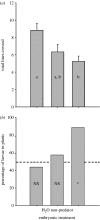Learning by embryos and the ghost of predation future
- PMID: 18682368
- PMCID: PMC2605805
- DOI: 10.1098/rspb.2008.0754
Learning by embryos and the ghost of predation future
Abstract
Most research on the effects of exposure to stressful stimuli during embryonic development has focused on post-embryonic behaviour that appears to be abnormal or maladaptive. Here, we tested whether exposure to some stressful stimuli (predatory cues) can lead to post-embryonic behaviour that is adaptive. When eggs of ringed salamanders (Ambystoma annulatum) were exposed to chemical cues from predators, post-hatching larvae showed reduced activity and greater shelter-seeking behaviour; larvae that had been exposed to control cues did not show these behaviours. In addition, wood frog (Rana sylvatica)tadpoles learned to respond to chemical cues from unfamiliar predators with danger based on embryonic conditioning. Therefore, if embryonic experience is a good predictor of future risk, learning associated with exposure to negative stimuli during development may be adaptive.
Figures


References
-
- Brodman R, Jaskula J. Activity and microhabitat use during interactions among five species of pond-breeding salamander larvae. Herpetologica. 2002;58:346–354. doi:10.1655/0018-0831(2002)058[0346:AAMUDI]2.0.CO;2 - DOI
-
- Brown G.E. Learning about danger: chemical alarm cues and local risk assessment in prey fishes. Fish Fish. 2003;4:227–234. doi:10.1046/j.1467-2979.2003.00132.x - DOI
-
- Davis P.D, Glynn L.M, Schetter C.D, Hobel C, Chicz-Demet A, Sandman C.A. Corticotropin-releasing hormone during pregnancy is associated with infant temperament. Devel. Neurosci. 2005;27:299–305. doi:10.1159/000086709 - DOI - PubMed
-
- Gosner K.L. A simplified table for staging anuran embryos and larvae with notes on identification. Herpetologica. 1960;16:183–190.
Publication types
MeSH terms
LinkOut - more resources
Full Text Sources

